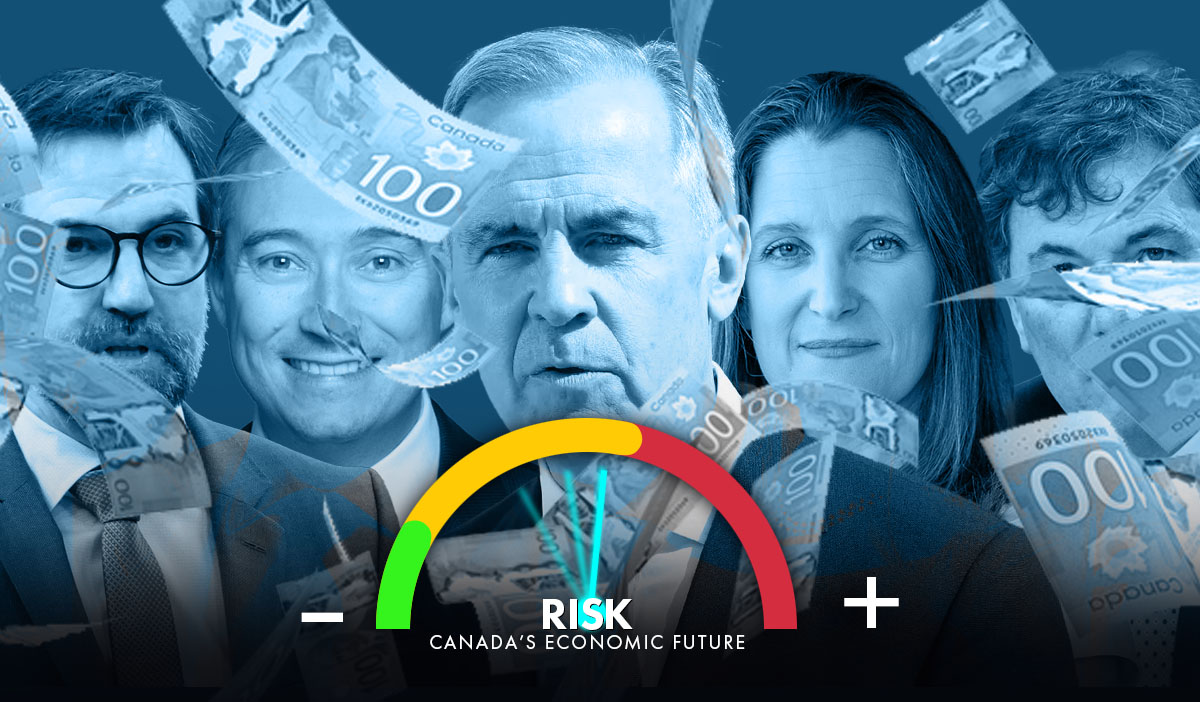
The Mirage of Carney’s ‘New Direction’: Same Players, Same Problems
Canada’s Economic Future at Risk: The Need for a Bold, Rebalanced Budget
According to the C.D. Howe Institute’s 2025 Shadow Budget, Canada’s fiscal future is facing unprecedented challenges and if the federal government continues on its current path, Canadians may face even tougher times ahead. The country’s economic situation requires urgent attention, with stagnant living standards, growing debt, and an increasingly aggressive U.S. trade policy putting immense pressure on Canada’s ability to compete and thrive.
A Legacy of Mismanagement and Undisciplined Spending
At the heart of the conversation is the mismanagement of Canada’s finances over recent years, a theme that the authors of the Shadow Budget, William B.P. Robson, Don Drummond, and Alexandre Laurin, make clear. They point to a disturbing trend of fiscal irresponsibility under the Trudeau Liberals, led by former Finance Minister Chrystia Freeland and Industry Minister François-Philippe Champagne-both of whom Mark Carney brought into his cabinet, signalling continuity in leadership despite the pressing need for change.
The Shadow Budget authors argue that the overshooting of deficit targets and an increase in the ratio of federal net debt to GDP—despite a growing economy—reflects a fundamental flaw in the government’s approach. Public finances, they say, have been undisciplined, leaving Canada ill-equipped to handle external threats, especially from the U.S.
“Undisciplined public finances and stagnant living standards put Canada in a poor position to deal with U.S. President Donald Trump’s economic attacks,” says William B.P. Robson, President and CEO of the C.D. Howe Institute. The harsh reality is that these financial missteps leave Canadians vulnerable to external shocks, making a solid, long-term plan for growth and defense all the more crucial.
Yet perhaps the most concerning aspect of Canada’s current trajectory is that Mark Carney, who now heads the government, has appointed many of the same individuals responsible for the nation’s current financial woes into his cabinet. Both Chrystia Freeland and François-Philippe Champagne, architects of the fiscal policies that have led to Canada’s growing debt and stagnating living standards, have been brought back into positions of power. This raises a serious question: why would Canadians trust the very figures who have contributed to the fiscal mismanagement to guide the country toward recovery?
Freeland, as finance minister, presided over years of ballooning deficits. Champagne handed out taxpayer-funded subsidies to auto companies for EVs like a drunken sailor as an industry minister yet failed to bring forward a coherent strategy to make Canadian businesses more competitive on the global stage. These same players, now in Carney’s cabinet, raise doubts about whether a real shift in direction is possible. With the same people at the helm, how can we expect a different outcome?
A Shadow Budget for Growth and Stability
The 2025 Shadow Budget proposes a bold path forward, one that seeks to turn around Canada’s fiscal trajectory and position the country for long-term growth. A core feature of the proposed budget is restoring budget surpluses by 2028/29, which would see the debt-to-GDP ratio drop from its current level of over 42 percent to a healthier 35 percent by 2029/30. This is done by reining in federal program spending, bringing it $28 billion below projections by 2029/30, and shifting the focus to areas that can directly foster economic expansion, like defense and innovation.
The Shadow Budget also emphasizes the need to increase defense spending to meet NATO’s two percent GDP target, recommending an additional $16 billion compared to the government’s current plans. This move is not just about military strength but about ensuring that Canada can stand strong in the face of global economic and geopolitical challenges.
A Comprehensive Review of Non-Defense Spending
“A centrepiece of this Shadow Budget is a comprehensive review of non-defense spending,” Robson explains. This includes rethinking tax expenditures—often disguised as spending programs—and ensuring that taxpayer dollars are being used as effectively and efficiently as possible. By reevaluating and trimming back inefficient programs, the government would free up funds to focus on areas critical to Canada’s future, like defense and border security, while minimizing future borrowing.
The proposed budget also calls for a shift in the tax burden, favouring policies that encourage work and investment. A key suggestion is raising the GST rate by two percentage points over two years to help fund the necessary increase in defense spending. At the same time, the plan proposes lowering personal and corporate income taxes, providing relief to hardworking Canadians and businesses alike.
Building a Competitive Tax System
In terms of economic competitiveness, the Shadow Budget proposes significant changes to Canada’s tax system. These include reducing the corporate income tax rate on income from patents and intellectual property generated in Canada and enhancing the effectiveness of the Scientific Research and Experimental Development (SR&ED) tax credit. Additionally, the introduction of an exemption from capital gains taxes on the sale of small-business shares is a step toward fostering innovation and investment in Canadian enterprises.
Moreover, the authors suggest creating a national commission to review the tax system comprehensively, ensuring that it is competitive on the global stage and better aligned with the country’s economic goals. This is a much-needed shift, one that seeks to overhaul a system that, according to the authors, has not served Canadians effectively in recent years.
Commitment to Fiscal Transparency
Fiscal transparency and accountability are critical to restoring public trust and ensuring the responsible management of taxpayer dollars. The Shadow Budget proposes that the government deliver its annual budget by the end of February each year and provide more accessible financial data to Canadians. This would include making the Main Estimates and public accounts more transparent and releasing them earlier in the year.
“These measures would make the budget process more transparent while also ensuring that future governments are held accountable for their spending decisions,” says Robson.
The Path Forward: A Renewed Vision for Canada’s Economy
Ultimately, the C.D. Howe Institute’s 2025 Shadow Budget is a call for action. It stresses the importance of disciplined fiscal management and a focus on long-term growth, which is sorely lacking under the current Liberal government. The proposed reforms are not merely about cutting costs—they are about setting Canada on a path to future prosperity and ensuring the country can face whatever challenges lie ahead, including the looming threat of U.S. trade aggression.
“It is the ‘economy-first’ budget Canada needs from the federal government in 2025,” conclude Robson, Drummond, and Laurin. If these ideas are adopted, the authors believe Canada could once again become a beacon of growth, competitiveness, and resilience in the global economy.
However, it remains to be seen whether Carney, with the same financial leaders who presided over the current mess in his cabinet, will be able to break from the very patterns that got Canada into this fiscal bind. Without new leadership—both in terms of policies and people—there’s a real risk that the nation could continue to stumble down the same costly path. And remember, it was Carney, who was one of Trudeau’s key economic advisers, that led us here.








